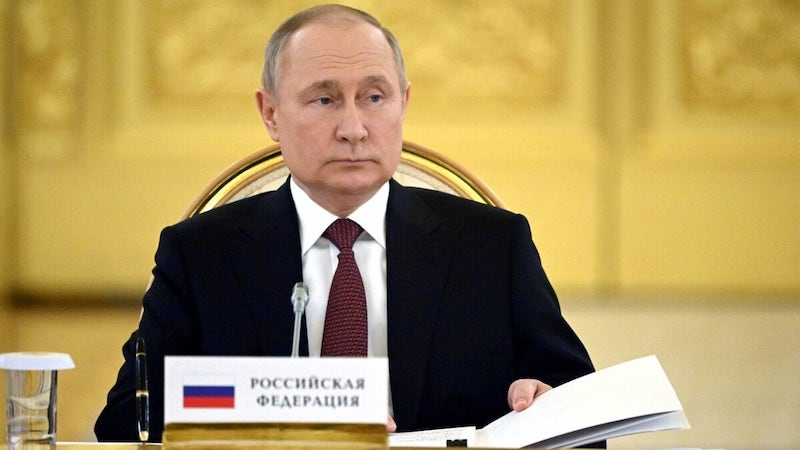
Forget Ukraine: Did Russians Try To Kill Putin?
The Kremlin drone incident could have been a way to signal the oligarchs are restless. If several Russian elites disappear in the coming days, that may answer the question of who was behind the incident. Putin, after all, has his own ways of sending a message.
By James Robbins, Fletcher School Alum and Senior Fellow in National Security Affairs at the American Foreign Policy Council.
What’s Behind Russia’s Drone Drama? – Just because Russian President Vladimir Putin is paranoid doesn’t mean they aren’t out to get him.
Early Wednesday morning, drones struck the Kremlin, bringing a taste of war to the heart of Moscow. Dramatic video showed drones descending, two explosions and the Senate Palace dome burning.
Russia blamed the Ukrainian government for the “premeditated terrorist attack and an assassination attempt targeting the President.” Moscow said it “reserves the right to take retaliatory measures wherever and whenever is deemed necessary.” Russian Security Council Deputy Chairman and former President Dmitry Medvedev was more to the point, declaring there are “no options left other than the physical elimination of [President Volodymyr] Zelensky and his clique.” Russia later claimed Ukraine was acting on the orders of the United States.
That Russia might resort to the “physical elimination” of Zelensky is hardly surprising or even unprecedented – there were several attempts to kill himin the opening days of the war, for example. Plus, the seemingly random Russian missile strikes on civilian targets in Kyiv and elsewhere may be aimed at Zelensky. For example, last June, Putin’s motorcade was see speeding to the Kremlin shortly before Russian missiles slammed into a Kyiv office park and apartment block. Did they think Zelensky was there? It is certainly possible.
Would Ukraine respond in kind to that sort of provocation? Military-grade drones could reach Moscow from Ukraine, a range of over five hundred miles. Russia was already preparing for a potential attack during its traditional May 9th World War II victory parade. In February, the Kremlin blamed Ukraine for an attempted drone strike near Kolomna, around 70 miles southeast of Moscow. A video of a Ukrainian drone hovering over Red Square that made the rounds a few weeks ago turned out to be doctored footage from 2015. So the drone attack concept is at least a possibility.
But Ukraine has forcefully denied it had anything to do with the strike. “We don’t attack Putin or Moscow,” Zelensky said. “We fight on our territory.”
So, if it wasn’t Ukraine, then who? One theory is that it was a false-flag attack, Putin attacking himself to establish a pretext of some kind. Certainly, Russia’s president isn’t above this sort of thing; questions still linger regarding the 1999 apartment bombings in Moscow that Putin used to justify a renewed war in Chechnya and to solidify his grasp on power. Government investigations of the attacks were inconclusive, and independent investigators and journalists asking too many questions about alleged involvement by Russia’s security services tended to die mysteriously.
But it is hard to understand what the Kremlin attack pretext might enable. Russia has already invaded Ukraine, already tried to kill Zelensky, already bombed civilian targets many times. What response from Moscow would escalate the conflict in a way they have not done already? The retaliatory missile strike launched Thursday likely would have been conducted even without the attack on the Kremlin. It is not like Russia has been showing restraint up until now.
To be sure, a staged attack be used to rally a Russian people increasingly weary of the war. However, it could also make the government look weak, unable to defend Russian airspace, and incapable of protecting its national symbols or top leaders. Blaming Kyiv makes the Ukrainians look daring, resourceful and terrifying.
A third option is that opposition elements within Russia launched the attack to send a signal to Putin that his time is running out. Over a year into its “special military operation” against Ukraine, Russia is an international pariah state, bleeding men and equipment at levels not seen since World War II, and getting little in return. This has generated growing dissent at home. The most public critics, such as Wagner Group chief Yevgeny Prigozhin, are not against the war per se, but object to how it is being conducted. Other dissidents may be keeping a lower profile because of the strange tendency of war critics to die by falling out of windows.
Ukrainian parliamentary leader David Arakhamia speculated that the attack was conducted by Russian oligarchs who have lost a collective $95 billion from war sanctions, and want things to go back to normal. Those insiders would have the means, motive and opportunity to launch a drone strike.
Whether it was a serious attempt to kill Putin is doubtful, given the nature of the targeting – striking the iron Kremlin dome rather than swooping into Putin’s quarters, for example. As well, Putin is protected at all times by layers of personal security, including jamming devices that capable of disrupting any drone guidance system, as well as anti-aircraft missiles. Taking him out by drone would be difficult, but not impossible.
So Wednesday’s Kremlin drone incident could have been a way to signal the oligarchs are restless. If several Russian elites disappear in the coming days, that may answer the question of who was behind the incident. Putin, after all, has his own ways of sending a message.
(This post is republished from 1945.)
